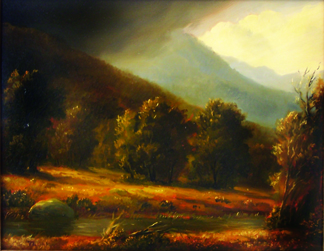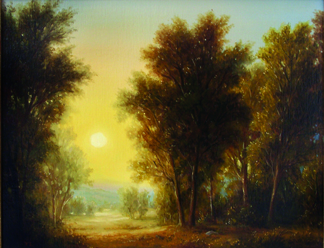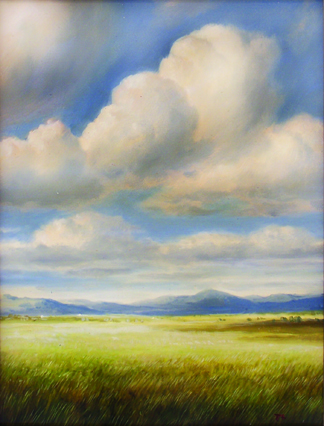 Essay on the Sublime |
By
RAYMOND J. STEINER
ART TIMES November 2007
Something
of that sensibility that these mountains were “special” — a manifestation
in the form of a “wall” presented to man by God Himself, i.e. ‘Manitou’
— was deeply felt by the first painters that came to the region,
the so-called “Hudson River School of Painters”, generally believed to
be “led” by Thomas Cole who often spoke of the “sublimity” of the natural
beauties of the surrounding landscape. Though the notion persists, there
was actually no such “school” at all — the appellation “Hudson River
Painters”, intoned nowadays in near-reverential delivery, was in fact
originally intended as a derogatory term used by big-city painters who
considered knocking around the wilds somewhat beneath the dignity of “real”
artists — there is little doubt that Cole and those who followed
him into the region did feel a certain awe when they brought their
sketch pads and traveling paint boxes into the Catskills. And, if we can
surmise his intent by the title of just one of Thomas Locker’s paintings
— “Essay on the Sublime” — then we must assume that the awe,
the feeling of being in the presence of the sublime, still exists to this
day.
 Morning Sun |
But
we need not trust to this one painting alone. That Thomas Locker emulates
Cole and his followers — if indeed is not directly influenced by
them — is evidenced by not only the title of another of his paintings,
“Homage to Thomas Cole”, but also by his painterly technique. A consummate
craftsman, Locker, of course, has the advantage of passed time on his
side, so we are able to also enjoy the spectacular red skies of a Frederic
Church, the dreamy and soft-edged vistas of a George Inness, or the skillful
play of light favored by the later “luminists” (another iffy term made
up by artwriters who didn’t seem to understand that the treatment of light
had played a major role in painting since earliest times). Likewise, following
the dicta of many of the “Hudson River Painters”, Locker prefers a landscape
unsullied by the presence of man — though he does allow barely discernible
buildings to appear in the distance, a building or two nestled behind
trees, a fence post or two presumably placed by some human hand
— even, in one painting, allowing a human form to stand in the foreground.
By and large, however, it is the notion of a landscape that is yet to
be subdued — ruined, if you will — by the intervention of
man and his artifacts.
Ironically,
the double conviction that Nature (with a capital ‘N’) was a sublime gift
of God and that America was offering the painter a newly-discovered,
“uncivilized” panorama, led to the paradox found in many of the “Hudson
River School” paintings, namely a landscape that in its depiction is soft-edged,
dreamy — “sublime” — anything, in short, but the raw countryside
that stood before their eyes. Part of the problem lies in the fact that
most early American painters learned their trade in Europe — where
most landscapes have been tamed by centuries of human habitation —
and a good deal of what we call “American” landscapes from the 19th-century
are little more than European transplants. Modern-day advocates of the
old tradition still persist in the ambiguity.
 Meadow in the Summer |
The Catskills might be old — not nearly as rugged
as the Alps or the newer Rockies — but, even today, they are not
so elegantly manicured as many of the “Hudson River School” painters and
their followers make them out to be. As beautiful as it may appear, Locker’s
“Fawn’s Leap”, for example, is somewhat more “user-friendly” than I remember
it. But then this, of course, is his intent; Locker means to make
it “sublime”. Locker, as is his imperative as an artist, is imposing his
aesthetic view on what he sees before him. An artist cannot do —
ought not do — less. The photographer can show us what is;
the painter must, in short, make us see what we are missing.
Thomas Locker, in his presentation of the region’s beauties,
does so with great sensibility and subtle finesse. The moods he captures
in such paintings as “Snow and Moon”, “Morning Mists” or “Essay on the
Sublime” are — like Cole’s, like Church’s, like Kensett’s —
his moods and he presents them forcefully and admirably. For those
lovers of landscape painting, it is difficult not to be moved by his cloudscapes
or his painterly treatment of water, trees, and distant hill. Whether
in small scale or large — something that gallery director Patty
Hanson emphasizes in her thoughtful hanging and spacing of each individual
painting — Locker presents us with insights into nature that can
make us catch our breath and stop to ponder — no small accomplishment
when we consider that the globe’s environment is threatened on a number
of fronts that loom on the horizon. You’ll like this show.
*“Paintings
by: Thomas Locker” (thru Dec 23): The Catskills Gallery, 106 Partition
St., Saugerties, NY (845) 246-5552
